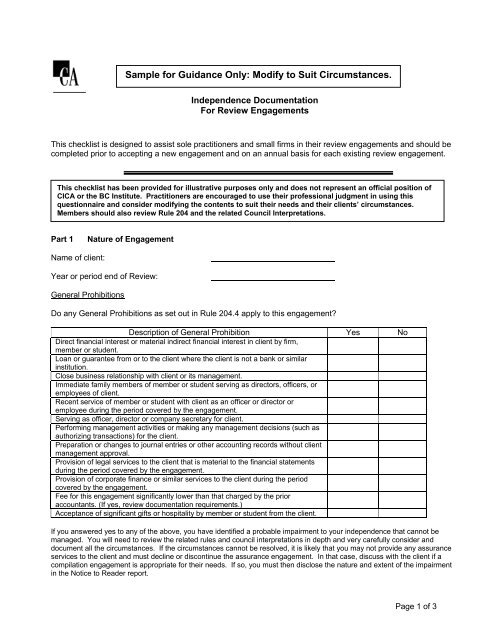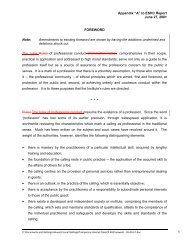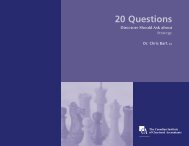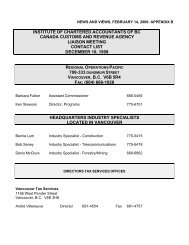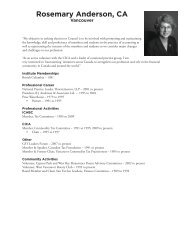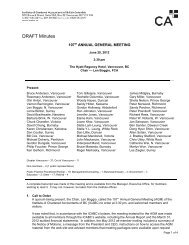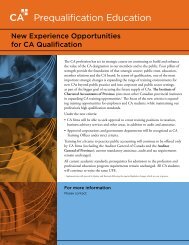Independence Documentation - Institute of Chartered Accountants of ...
Independence Documentation - Institute of Chartered Accountants of ...
Independence Documentation - Institute of Chartered Accountants of ...
Create successful ePaper yourself
Turn your PDF publications into a flip-book with our unique Google optimized e-Paper software.
Sample for Guidance Only: Modify to Suit Circumstances.<br />
<strong>Independence</strong> <strong>Documentation</strong><br />
For Review Engagements<br />
This checklist is designed to assist sole practitioners and small firms in their review engagements and should be<br />
completed prior to accepting a new engagement and on an annual basis for each existing review engagement.<br />
This checklist has been provided for illustrative purposes only and does not represent an <strong>of</strong>ficial position <strong>of</strong><br />
CICA or the BC <strong>Institute</strong>. Practitioners are encouraged to use their pr<strong>of</strong>essional judgment in using this<br />
questionnaire and consider modifying the contents to suit their needs and their clients’ circumstances.<br />
Members should also review Rule 204 and the related Council Interpretations.<br />
Part 1<br />
Nature <strong>of</strong> Engagement<br />
Name <strong>of</strong> client:<br />
Year or period end <strong>of</strong> Review:<br />
General Prohibitions<br />
Do any General Prohibitions as set out in Rule 204.4 apply to this engagement<br />
Description <strong>of</strong> General Prohibition Yes No<br />
Direct financial interest or material indirect financial interest in client by firm,<br />
member or student.<br />
Loan or guarantee from or to the client where the client is not a bank or similar<br />
institution.<br />
Close business relationship with client or its management.<br />
Immediate family members <strong>of</strong> member or student serving as directors, <strong>of</strong>ficers, or<br />
employees <strong>of</strong> client.<br />
Recent service <strong>of</strong> member or student with client as an <strong>of</strong>ficer or director or<br />
employee during the period covered by the engagement.<br />
Serving as <strong>of</strong>ficer, director or company secretary for client.<br />
Performing management activities or making any management decisions (such as<br />
authorizing transactions) for the client.<br />
Preparation or changes to journal entries or other accounting records without client<br />
management approval.<br />
Provision <strong>of</strong> legal services to the client that is material to the financial statements<br />
during the period covered by the engagement.<br />
Provision <strong>of</strong> corporate finance or similar services to the client during the period<br />
covered by the engagement.<br />
Fee for this engagement significantly lower than that charged by the prior<br />
accountants. (If yes, review documentation requirements.)<br />
Acceptance <strong>of</strong> significant gifts or hospitality by member or student from the client.<br />
If you answered yes to any <strong>of</strong> the above, you have identified a probable impairment to your independence that cannot be<br />
managed. You will need to review the related rules and council interpretations in depth and very carefully consider and<br />
document all the circumstances. If the circumstances cannot be resolved, it is likely that you may not provide any assurance<br />
services to the client and must decline or discontinue the assurance engagement. In that case, discuss with the client if a<br />
compilation engagement is appropriate for their needs. If so, you must then disclose the nature and extent <strong>of</strong> the impairment<br />
in the Notice to Reader report.<br />
Page 1 <strong>of</strong> 3
<strong>Independence</strong> <strong>Documentation</strong><br />
Part 2<br />
Threats<br />
Threat (See Notes for details) Yes No<br />
Are there self-interest threats related to this client<br />
Are there self-review threats related to this client<br />
Are there advocacy threats related to this client<br />
Are there familiarity threats related to this client<br />
Are there intimidation threats related to this client<br />
Are there other circumstances that would threaten your independence or the<br />
appearance <strong>of</strong> your independence<br />
If yes, describe in detail and include factors such as materiality and the nature <strong>of</strong><br />
the engagement:<br />
Are there any significant threats to your independence or the appearance <strong>of</strong> your independence ⃞ Yes ⃞ No<br />
If yes, proceed to Part 3 Safeguards to identify possible safeguards that may eliminate or reduce threats to an<br />
acceptable level.<br />
If no, proceed to Part 4 Conclusion to document the insignificance <strong>of</strong> threats before proceeding with engagement.<br />
Part 3<br />
Safeguards<br />
Safeguard Yes No<br />
Are the results <strong>of</strong> the services explained to the client<br />
Is client approval and acceptance for the results <strong>of</strong> the engagement obtained<br />
Did the firm pass the last provincial practice inspection<br />
Has the firm consulted with staff from the provincial <strong>Institute</strong> about the threats to its<br />
independence<br />
Describe other safeguards that may eliminate threats to your independence or reduce them to an acceptable level.<br />
Part 4<br />
Conclusion<br />
Are the threats to independence insignificant ⃞ Yes ⃞ No<br />
OR<br />
Are the safeguards effective in eliminating the threats or reducing them to an acceptable level ⃞ Yes ⃞ No<br />
Should the firm accept or continue with the engagement ⃞ Yes ⃞ No<br />
Practice Aid – Review Engagements Page 2 <strong>of</strong> 3
<strong>Independence</strong> <strong>Documentation</strong><br />
Other comments<br />
Prepared by:<br />
Approved by:<br />
Date:<br />
Date:<br />
NOTES<br />
Part 2<br />
Threats:<br />
A self-interest threat occurs when a firm or a person on the engagement team could benefit from a financial interest in,<br />
or other self-interest conflict with, an assurance client. Examples include:<br />
• Dependence by the firm as a whole or by an individual partner on total fees from this client.<br />
• Serious concern about the possibility <strong>of</strong> losing the engagement.<br />
• Significant amount <strong>of</strong> unpaid fees from prior engagements.<br />
A self-review threat occurs when any product or judgment from a previous engagement needs to be evaluated in<br />
reaching conclusions on the particular assurance engagement. Examples include:<br />
• Member <strong>of</strong> the firm or the firm performed services for this client that directly affect the subject matter <strong>of</strong> the<br />
engagement.<br />
• Member <strong>of</strong> the firm or the firm prepared any original data or records that are the subject matter <strong>of</strong> the<br />
engagement.<br />
An advocacy threat occurs when a firm, or a person on the engagement team, promotes, or may be perceived to<br />
promote, an assurance client’s position or opinion to the point that objectivity may, or may be perceived to be, impaired.<br />
Examples include:<br />
• Member <strong>of</strong> the firm or the firm dealt in or promoted shares or other securities <strong>of</strong> this client.<br />
• Member <strong>of</strong> the firm or the firm acted as an advocate on behalf <strong>of</strong> an assurance client in litigation or in resolving<br />
disputes with third parties.<br />
A familiarity threat occurs when, by virtue <strong>of</strong> a close or long-term relationship with an assurance client, its directors,<br />
<strong>of</strong>ficers or employees, a firm or a person on the engagement team becomes too sympathetic to the client’s interests.<br />
Examples include:<br />
• A former partner <strong>of</strong> the firm is a director, <strong>of</strong>ficer or employee <strong>of</strong> the client in a position to exert direct and<br />
significant influence over the subject matter <strong>of</strong> this engagement.<br />
• There is a long association <strong>of</strong> a senior person on the engagement team with the client.<br />
An intimidation threat occurs when a person on the engagement team may be deterred from acting objectively and<br />
exercising pr<strong>of</strong>essional scepticism by threats, actual or perceived, from the directors, <strong>of</strong>ficers or employees <strong>of</strong> an<br />
assurance client. Examples include:<br />
• Client threatened to replace the firm due to a disagreement with the application <strong>of</strong> an accounting principle.<br />
• Client applied pressure to inappropriately reduce the extent <strong>of</strong> work performed in order to reduce or limit fees.<br />
• There is actual or threatened litigation between the firm and this client.<br />
Practice Aid – Review Engagements Page 3 <strong>of</strong> 3


